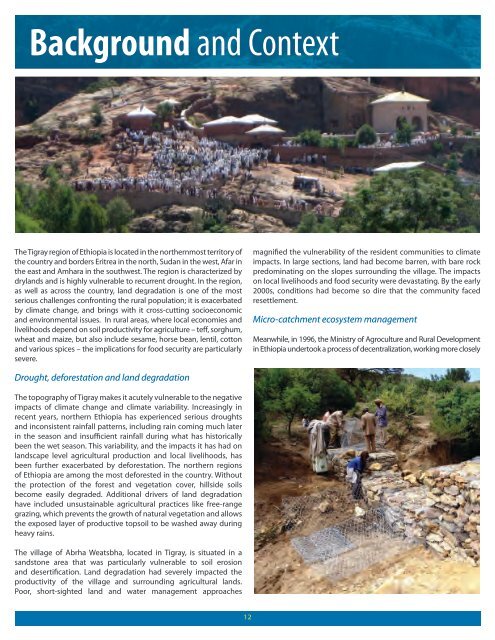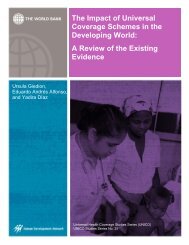11ZAQGM
11ZAQGM
11ZAQGM
Create successful ePaper yourself
Turn your PDF publications into a flip-book with our unique Google optimized e-Paper software.
Background and Context<br />
The Tigray region of Ethiopia is located in the northernmost territory of<br />
the country and borders Eritrea in the north, Sudan in the west, Afar in<br />
the east and Amhara in the southwest. The region is characterized by<br />
drylands and is highly vulnerable to recurrent drought. In the region,<br />
as well as across the country, land degradation is one of the most<br />
serious challenges confronting the rural population; it is exacerbated<br />
by climate change, and brings with it cross-cutting socioeconomic<br />
and environmental issues. In rural areas, where local economies and<br />
livelihoods depend on soil productivity for agriculture – teff, sorghum,<br />
wheat and maize, but also include sesame, horse bean, lentil, cotton<br />
and various spices – the implications for food security are particularly<br />
severe.<br />
magnified the vulnerability of the resident communities to climate<br />
impacts. In large sections, land had become barren, with bare rock<br />
predominating on the slopes surrounding the village. The impacts<br />
on local livelihoods and food security were devastating. By the early<br />
2000s, conditions had become so dire that the community faced<br />
resettlement.<br />
Micro-catchment ecosystem management<br />
Meanwhile, in 1996, the Ministry of Agroculture and Rural Development<br />
in Ethiopia undertook a process of decentralization, working more closely<br />
Drought, deforestation and land degradation<br />
The topography of Tigray makes it acutely vulnerable to the negative<br />
impacts of climate change and climate variability. Increasingly in<br />
recent years, northern Ethiopia has experienced serious droughts<br />
and inconsistent rainfall patterns, including rain coming much later<br />
in the season and insufficient rainfall during what has historically<br />
been the wet season. This variability, and the impacts it has had on<br />
landscape level agricultural production and local livelihoods, has<br />
been further exacerbated by deforestation. The northern regions<br />
of Ethiopia are among the most deforested in the country. Without<br />
the protection of the forest and vegetation cover, hillside soils<br />
become easily degraded. Additional drivers of land degradation<br />
have included unsustainable agricultural practices like free-range<br />
grazing, which prevents the growth of natural vegetation and allows<br />
the exposed layer of productive topsoil to be washed away during<br />
heavy rains.<br />
The village of Abrha Weatsbha, located in Tigray, is situated in a<br />
sandstone area that was particularly vulnerable to soil erosion<br />
and desertification. Land degradation had severely impacted the<br />
productivity of the village and surrounding agricultural lands.<br />
Poor, short-sighted land and water management approaches<br />
12






